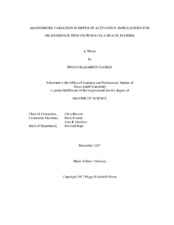| dc.contributor.advisor | Houser, Chris | |
| dc.creator | Flores, Peggy Elizabeth | |
| dc.date.accessioned | 2019-01-16T20:43:47Z | |
| dc.date.available | 2019-12-01T06:35:25Z | |
| dc.date.created | 2017-12 | |
| dc.date.issued | 2017-12-08 | |
| dc.date.submitted | December 2017 | |
| dc.identifier.uri | https://hdl.handle.net/1969.1/173162 | |
| dc.description.abstract | The Deepwater Horizon Oil Spill in 2010 released approximately 5 million barrels of oil into the Gulf of Mexico just as the nearshore and beach profile were recovering from winter storms. As a consequence, oil mats and tar balls were trapped at depth within the beach and nearshore profile. Excavation of this buried oil during subsequent storms creates the potential for the contamination of adjacent beaches and the degradation of marine ecosystems, which can in turn negatively impact local economies that depend on fisheries and tourism. The potential for oil burial and persistence is dependent on three things: the physio-chemical nature of the oil as it reaches the nearshore environment, the pre-existing morphology of the beach and nearshore, and the evolution of that morphology after the oil is deposited. The depth at which the oil is buried is also dependent on the beach profile during the time of the spill. The purpose of this study is to characterize the alongshore variation in depth of activation on a Deepwater Horizon impacted section of Pensacola Beach, Florida with regards to the implications of oil residence time. Ground- Penetrating Radar (GPR) surveys were conducted along two parallel 1-km transects adjacent to the swash zone and the dunes. Additional cross- shore transects were completed every 150 m from the base of the dunes to the top of the swash zone. Sediment cores were taken at the crossing points of the alongshore and cross-shore transects, to calibrate the GPR surveys and complete an elemental analysis for the identification of storm layers and the presence of buried oil. Results will show implications for oil residence time with regards to the evolution of the beach envelope. | en |
| dc.format.mimetype | application/pdf | |
| dc.language.iso | en | |
| dc.subject | Oil Spill | en |
| dc.subject | Oil Residence Time | en |
| dc.subject | Coastal Geomorphology | en |
| dc.subject | Ground Penetrating Radar | en |
| dc.subject | Pensacola | en |
| dc.subject | Deepwater Horizon Oil Spill | en |
| dc.subject | Clean Up | en |
| dc.title | Alongshore Variation in Depth of Activation: Implications for Oil Residence Time on Pensacola Beach, Florida | en |
| dc.type | Thesis | en |
| thesis.degree.department | Geology and Geophysics | en |
| thesis.degree.discipline | Geology | en |
| thesis.degree.grantor | Texas A & M University | en |
| thesis.degree.name | Master of Science | en |
| thesis.degree.level | Masters | en |
| dc.contributor.committeeMember | Giardino, John R | |
| dc.contributor.committeeMember | Everett, Mark | |
| dc.type.material | text | en |
| dc.date.updated | 2019-01-16T20:43:47Z | |
| local.embargo.terms | 2019-12-01 | |
| local.etdauthor.orcid | 0000-0002-1071-2816 | |


